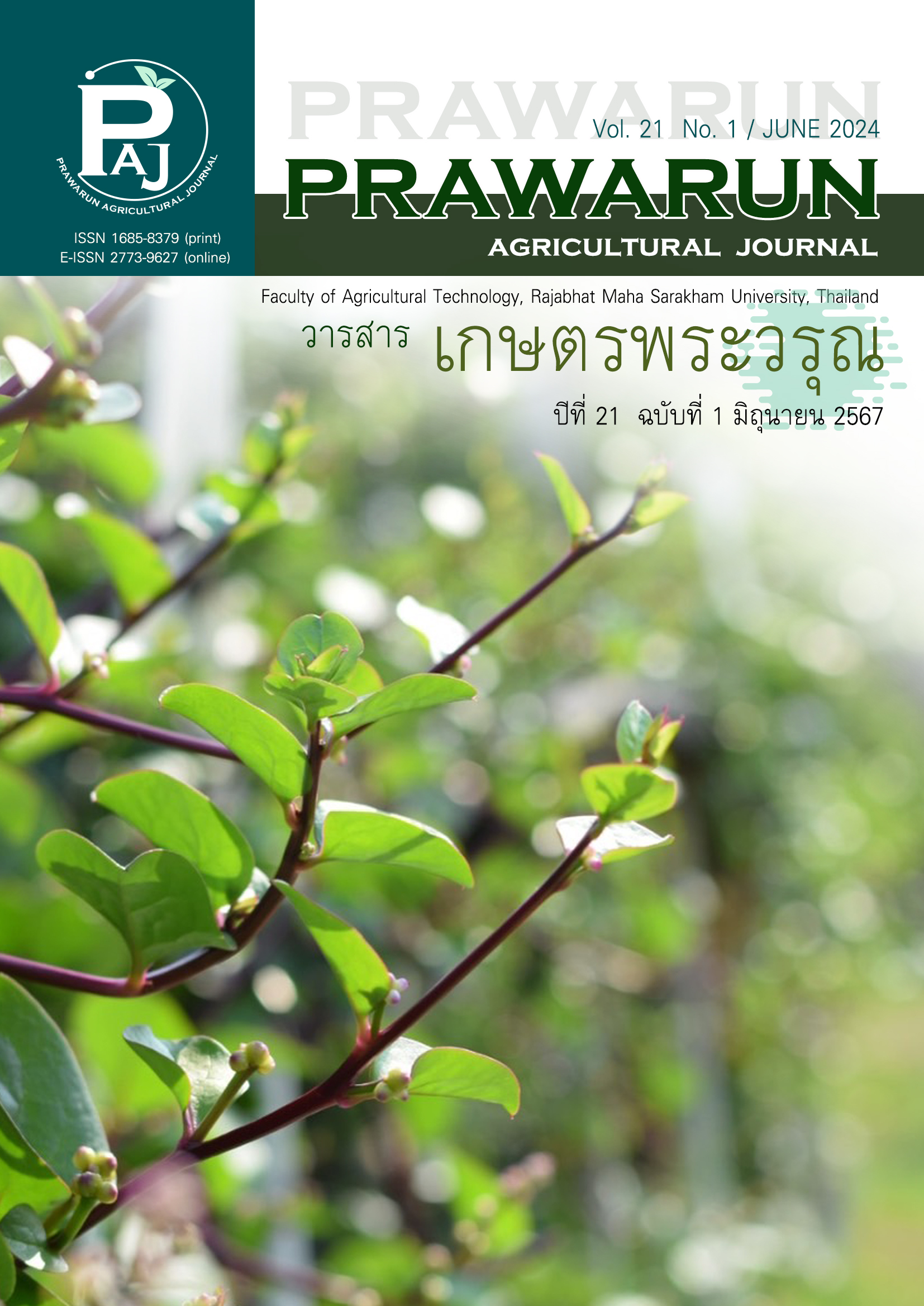Development of macaron product from used coconut residue
Main Article Content
Abstract
This research examines the development of macarons using coconut residue. Physicochemical properties, types of meringues, effects on quality, nutritional value, and consumer acceptance of macarons were analyzed. Coconut residue showed L* a* b* values of 89.77, 0.41, and 9.51, respectively, with moisture, ash, fat, protein, carbohydrate, and dietary fiber percentages being 4.10, 1.21, 42.41, 4.27, 48.01, and 36.27, respectively. It was found that the Italian meringue technique shows the structural strength of egg whites. Sensory evaluation indicated that Italian meringue was more preferred than French or Swiss types. Increasing coconut residue in the macaron recipe reduced the L* value while increasing a* and b* values without significantly affecting moisture and water activity (aw) compared to the control recipe. Hardness increased, but crispness decreased as the proportion of coconut residue rose. Furthermore, dietary fiber in macarons increased with higher coconut residue content. Consumer acceptance tests showed that macarons with a ratio of 2:1 (almond powder: coconut powder) were accepted similarly to the control recipe, but acceptance tended to decrease with higher coconut residue ratios. Thus, using a ratio of 2:1 (almond powder: coconut powder) in macaron production is deemed optimal, enhancing nutritional value while maintaining high consumer acceptance, and presenting a new approach to utilizing leftover materials effectively.
Article Details
References
Adeloye, J. B., Osho, H., & Idris, L. O. (2020). Defatted coconut flour improved the bioactive components, dietary fibre, antioxidant and sensory properties of nixtamalized maize flour. Journal of Agriculture and Food Research, 2(4), 100042. doi: 10.1016/j.jafr.2020.100042
Association of Official Analytical Chemists (AOAC). (2016). Official methods of analysis. (20thed.). Washington D.C., United States: Association of Analytical Chemists.
Boonna, P., Manarote, A., Panyathitipong, W., & Masavang, S. (2022). Effect of sugar content on physical and sensory properties of tapioca-based cookies. Journal of Applied Research on Science and Technology (JARST), 21(2), 14-25. (in Thai) doi: 10.14456/jarst.2022.14
Boonsiriwit, A., & Sriwarom, N. (2018). Processing of egg white pastries (macaroon) by using peanut and cashew nut powder as almond powder replacement. Dusit Thani College Journal, 12(2), 182–192. (in Thai)
Chinnasarn, S., & Chinnasarn, K. (2015). Extraction and utilization of dietary fiber and cellulose from coconut residue for value creation of agricultural by-products and mass transfer prediction models during frying process (Research report). Chonburi, Thailand: Burapha University. (in Thai)
Chiralaksanakul, N. (2018). Effects of mixing time before baking, egg white aging, reduction of sugar and icing sugar content on the quality of macaron shells (Master’s thesis). Bangkok, Thailand: King Mongkut's Institute of Technology Ladkrabang. (in Thai)
Chomchom, N., Uppathak, C. & Sakunyuenyongsuk, N. (2013). Development of Thai dessert product from used coconut residue (Research report). Bangkok, Thailand: Rajamangala University of Technology Phra Nakhon. (in Thai)
Department of Agriculture. (2020). Coconut production situation. Accessed May 6, 2022. Retrieved from https://www.doa.go.th. (in Thai)
Eadmusik, S., Phungamngoen, C., Panphut, W., & Budsabun, T. (2022). Partially substitution of wheat flour by coconut residues in bakery products and their physical and sensorial properties. Food Research, 6(1), 99-105. doi: 10.26656/fr.2017.6(1).140
Marikkar, J. M. N., & Madurapperuma, W. S. (2012). Coconut. In M. Siddiq (Ed.) Tropical and subtropical fruits: Postharvest physiology, processing and packaging (pp. 159-177). Iowa, USA: John Wiley & Sons. doi: 10.1002/9781118324097.ch9
Panyayong, C., & Khantasen, V. (2018). Development of almond powder substitute macaron form cashew nut powder. Srinakharinwirot University (Journal of Science and Technology), 10(19), 14-30. (in Thai)
Pedcharat, K., Sae-Tang, D., & Tungsatitporn, D. (2014). Development of food products from used coconut residue. (Research Report). Bangkok, Thailand: Rajamangala University of Technology Phra Nakhon. (in Thai)
Portugal, T. R., Parcon, M. R. V., & Udarbe, M. A. (2013). Proficiency test on total dietary fiber in wheat flour. International Journal of Chemical Engineering and Applications, 4(2), 82-87.
Quan, T. H., & Benjakul, S. (2019). Duck egg albumen: physicochemical and functional properties as affected by storage and processing. Journal of Food Science and Technology, 56(3), 1104-1115.
doi: 10.1007/s13197-019-03669-x
Raiva, P. (2016). Thai bakery industry. Accessed July 20, 2022. Retrieved from http://fic.nfi.or.th/foodindustry_ceo_view.php?smid=1126. (in Thai)
Reitz, N. F. (2016). Investigating the chemical basis of functionality differences between beet and cane sugar sources in model egg white foams and other products (Master’s thesis). Illinois, United States: University of Illinois at Urbana-Champaign.
Siyunglek, M., Techakriengkrai, T., & Siriwong, N. (2020). Preparation and application of dried almond residue for substitution of almond flour in macaron. Thai Science and Technology Journal, 28(9), 1572-1584. (in Thai) doi: 10.14456/tstj.2020.125
Sykut-Domańska, E., Zarzycki, P., Sobota, A., Teterycz, D., Wirkijowska, A., Blicharz-Kania, A., Andrejko, D., & Mazurkiewicz, J. (2020). The potential use of by-products from coconut industry for production of pasta. Journal of Food Processing and Preservation, 44(7), e14490. doi: 10.1111/jfpp.14490
Thai Industrial Standards Institute. (2005). Thai community product standard of Khanom Ping. TCPS no. 745/2548. Bangkok, Thailand: Thai Industrial Standards Institute. (in Thai)
Thinkarn, K. (2019). Coconut meal clay development for craft products (Master’s thesis). Pathum Thani, Thailand: Rajamangala University of Technology Thanyaburi. (in Thai)
Trinidad, T. P., Mallillin, A. C., Valdez, D. H., Loyola, A. S., Askali-Mercado, F. C., Castillo, J. C., Encabo,
R. R., Masa, D. B., Maglaya, A. S., & Chua, M. T. (2006). Dietary fiber from coconut flour: a functional food. Innovative Food Science & Emerging Technologies, 7(4), 309-317.
doi: 10.1016/j.ifset.2004.04.003
Wirkijowska, A., Sobota, A., Zarzycki, P., Nawrocka, A., Blicharz-Kania, A., & Andrejko, D. (2021). Chemical, technological, and sensory evaluation of the suitability of coconut by-products in white rolls. Journal of the Science of Food and Agriculture, 102(8), 3370-3378.
doi: 10.1002/jsfa.11684
Yalegama, L. L. W. C., Karunaratne, D. N., Sivakanesan, R., & Jayasekara, C. (2013). Chemical and functional properties of fibre concentrates obtained from by-products of coconut kernel. Food Chemistry, 141(1), 124-130. doi: 10.1016/j.foodchem.2013.02.118
Yang, X., & Foegeding, E. A. (2010). Effects of sucrose on egg white protein and whey protein isolate foams: factors determining properties of wet and dry foams (cakes). Food Hydrocolloids, 24(2-3), 227-238. doi: 10.1016/j.foodhyd.2009.09.011


